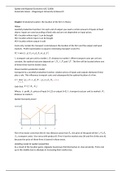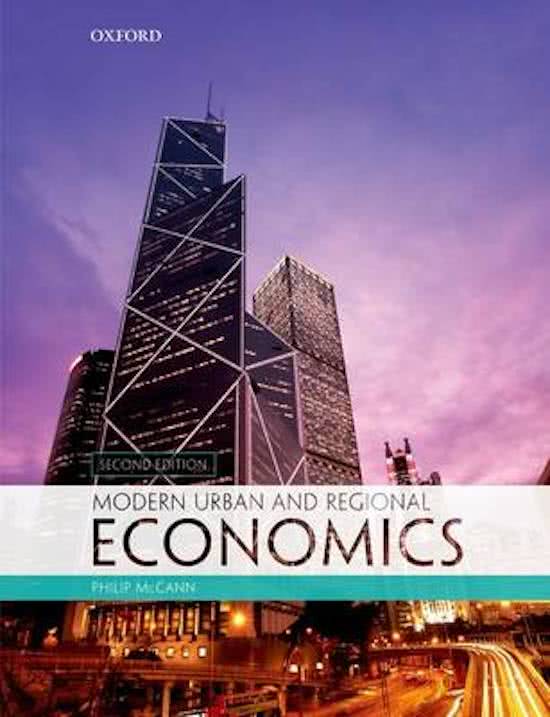Spatial and Regional Economics UEC-22806
Annemiek Jansen - Wageningen University & Research
Chapter 1 Industrial location: the location of the firm in theory
Weber
Leontief production function= for each unit of output you need a certain amount of inputs in fixed
shares. Inputs are used according a fixed ratio and are not dependent on input prices.
M1= location where input 1 can be bought
M2= location where input 2 can be bought
M3= location where output is sold
Costs only contain the transport costs between the location of the firm and the output and input
markets . Profit maximization is equal to minimizing transport costs (TC).
TC=min [t 1 d1 X 1 +t 2 d 2 X 2 +t 3 d 3 Y ]
t i: transport cost per unit to market i, d i: distance to market i. When transport costs per unit are
constant, the optimal outcome depends on t 1 X 1 , t 2 X 2and t 3 Y . The firm will be located where one
of these three has the lowest value.
Moses location-production model
Compared to a Leontief production function, relative prices of inputs and outputs (between firms)
play a role. This influences transport costs and subsequently the optimal location of a firm.
π= max (p ¿ ¿ 3−t 3 d3 )Y −( p1 +t 1 d 1 ) X 1−¿ ¿ ¿
Y , X1, X2
Such that: Y =f ( X 1 , X 2 )
Where: π : profit, pi: prices of input (i=1,2) or output (i=3), t i: transport cost per unit to market i, d i:
distance to market i.
Spatial monopoly power
Firm A has lower costs than firm B. Any distance away from d a , the price of the good will be c a +t a d a
( t a: transport costs). Vice versa with product B. Firm A has the market area OX and firm B the area XL
because the price of these firms is lowest in those areas.
Hotelling model of spatial competition
As a result of the location game, oligopoly businesses find themselves in close proximity. Firms end
up in the middle due to attempts in increasing their market size.
,Spatial and Regional Economics UEC-22806
Annemiek Jansen - Wageningen University & Research
Outcome is a Nash equilibrium where no firm can increase profit by changing its location.
- Welfare change consumers in the centre of the market (X) = + eghj
- Welfare change producers on the edges of the market (O and L) = -cdef and -jklm
- Net effect is a welfare loss
- OL is considered as the ‘product characteristic space’
The location game is considered a non-price competition where firms avoid price competition. Firms
compete on non-price factors, f.e. location. Otherwise this will lead to a Bertrand competition: A
market structure where it is assumed that there are two firms, who both assume the other firm will
keep prices unchanged. Eeach firm has an incentive to cut prices, but this leads to a price war. If
products are perfect substitutes this assumes the price will be driven down to marginal cost.
Hotelling paradox
In order to avoid Bertrand competition, the mutual interdependence of firms gives rise to firms
producing the same products, selling them in the same location (clusters) while using non-price
competition to make the products appear different to each other.
But: firms that produce identical products (gasoline) in which non-price competition is difficult, will
not cluster in space.
Unstable model: if consumers realise products are substitutes, they will easily switch. Implies a 0/1
(survive/ non survive) outcome. This is not was is seen in reality.
Salop model of product
Consumers have no longer identical preferences, compared to the hotelling model. Each consumer
has a different product space location. With many varieties of a product, product space locations
overlap price competition plays a role.
,Spatial and Regional Economics UEC-22806
Annemiek Jansen - Wageningen University & Research
Consumers have more choice and a small price movement of the variety of one single firm has less
effect on total demand which leads to a stable outcome. Stable local market demand is good for both
consumers and producers.
Chapter 2 Agglomeration and clustering
Sources of agglomeration economies
Why do firms cluster or why are there ‘external economies of scale’ or ‘agglomeration effects’?
1. Knowledge spill overs: proximity maximizes the mutual accessibility of all individuals within
the cluster, thereby the knowledge and information available.
2. Local non-traded inputs:
A) specialist firms that provide specialist information and services (legal and software firms).
B) specialist local infrastructure (f.e. wide-band cable system) that lower costs of non-trade
input when the cluster consists out of more firms.
3. Local skilled labour pool: a specialized local labour pool reduces labour acquisition costs.
Labour availability pushes down wages and training costs.
External economies of scale: caused by changes outside the firm.
Internal economies of scale: firm specific, caused internally.
Both types result in declining marginal costs.
Types of agglomeration economies
1. Internal returns to scale: Clustering of production factors lowers production costs (larger
stock). An increasing returns to scale occurs when the output increases by a larger
proportion than the increase in inputs during the production process. (Boing in Seattle).
2. Economies of localization: A group of firms within the same industrial sector is located at the
same place. (Firms delivering parts to Boing in Seattle). An increase in the size of an industry
in a city leads to an increase in productivity of a particular activity.
3. Economies of urbanization: economies of agglomeration which accrue to firms across
different sectors. (Firms that deliver inputs to Boeing, like catering and security).
Alternative descriptions of industrial clusters
1. Growth pole model: Large innovative firms or investment activities have significant impacts
on the local development of industrial clusters (core of cluster).
2. Incubator model: A larger diversity of local sectors, firm sizes, and firm types may be
important for the growth of a cluster, as it provides greater potential opportunities for firms
to find new market niches (heterogeneous firms and products leads to innovation).
3. Product cycle model: Geographically peripheral areas, that exhibit lower labour costs and
labour skills, will tend to have produce more mature, less novel, and more standardized
products compared to central city-regions.
4. Porter model: Localized competition drives innovation, which increases the competition of a
cluster as a whole. More dynamic approach than incubator model.
5. New industrial areas model: industries made up of spatial networks or clusters of small firms,
tend to be more innovative that industries consisting of large firms. Risk taking is facilitated
because of trust (facilitated by proximity) between local decision makers.
, Spatial and Regional Economics UEC-22806
Annemiek Jansen - Wageningen University & Research
Typologies of industrial clusters however can overlap.
People clustering
1. Creative class hypothesis: Places that are tolerant of cultural diversity and cultural
differences are environments which are ideally suited for fostering unconventional
approaches to the development of novel ideas, systems, products or services. The in-
migration of creative people reinforces this.
2. Consumer city hypothesis. High-skilled and high-income people will increasingly migrate
towards cities offering high-quality amenities, such as opera houses, museums, etc.
Critique on profit maximization
1. Bounded rationality – Limited information makes profit maximization impossible. This implies
that firms choose more simple optimisation rules (revenue maximization).
2. Conflicting goals – More simple or multiple goals lead to other outcomes.
3. Relocation costs – The extra profit a new location brings should be higher than relocation
costs.
The leading-follower behaviour in which smaller firms cluster together close to large firms is a
strategy to survive in a situation of limited information.
Chapter 3 The spatial distribution of activities
Firms dispersal
In the case the arguments for agglomeration do not apply, firms will be dispersed. Dispersal is often
the case with:
- Strong price competition (e.g. agriculture)
- Firms with spatial monopoly power (milk processing)
Spatial monopoly power can also lead to price discrimination, by charging high prices for local
customers in favour of distant customers.
Reilly’s law
The ability of a market to attract consumers depends directly on the size of the market (measured as
the number or variety of goods being produced or available at the market) and indirectly to the
square of the distance (measured as the distance consumers have to travel to the market).






